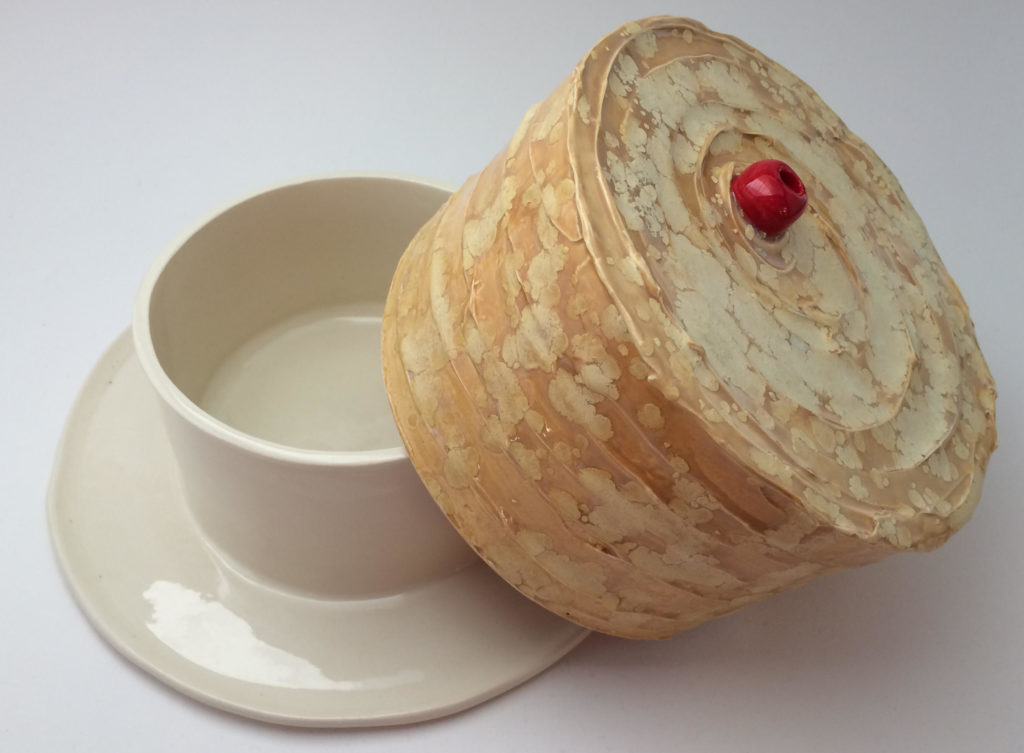It’s your turn to prepare the sweet bread for the Christmas family gathering this year. Your mother used to take care of it, and her mother before her. But with those matriarchs gone the responsibility now falls to you, the eldest woman in the family. You’ve baked before: nutmeg cakes for potlucks, baklava for your husband’s birthday. But you’ve never done anything of this size and importance, and the task is daunting. You try to remember how your mother did it. You wish you took notes when you had the chance. In the end, it’s the power of your memory, your talent for improvisation, and the internet that come to your aid.
You begin by dissolving yeast and sugar in warm milk before adding melted butter. You beat five eggs and add them to the concoction, with flour, salt and ground mahleb. As you knead this mixture bits of it stick to your hands, leaving patches on the tips of your fingers and under your nails. When your arms feel sore you switch to using the stand mixer.
You put the dough in a well-oiled bowl and let it sit for an hour and a half until it doubles in size. You then lay it on a large pan and shape it. Your mother used to braid the dough, but you simply spread it out so it bakes into a slab the size of an extra-large pizza. You don’t have the time and patience to attempt anything else. As you work, you mentally prepare your retorts in case anyone comments on it.
Before placing the pan in the oven, you stick a toonie wrapped in aluminium foil inside the dough. This is the prize, the treasure every family member yearns to find. Encountering it means you will have good luck for the following year. It’s nothing but superstition, but deep down you believe it.

Cake by Marla Benton
The family rarely comments on the taste of the bread, its look or its texture. All that matters is what is to be found inside. You’ve never won the coin. Your mother did, four times. Her mother won it twice. You’ve never had that kind of luck, but maybe this year the coin will be yours. Your reward for your hard work.
You buckle under the sweet bread’s weight as you pull it from the oven. Once it cools down, you put it in a bag—any large bag will do, considering its size. When it’s time to leave, you ask your husband to help you carry it to the car. It takes up most of the backseat, and you listen to it slide and bump on the drive over to your cousin’s house.
You give your cousin a quick peck on the cheek when you arrive, then bypass everyone else on your way to the kitchen to set the pan on the counter. The sweet bread has its own distinguished place, away from the other dishes. There are exclaims of surprise, remarks of how big it is. These are followed by words of encouragement. They’re sure it turned out well. They’re grateful you took on the task of making it. They reassure you with rueful smiles that your mother would be proud.
The sweet bread is cut after the main course, but right before dessert. You wield the knife, since this behemoth is deemed your responsibility. You try to cut it in evenly-sized slices, but some pieces turn out bigger than others. If your relatives notice, they’re kind enough not to comment. In accordance with tradition, the youngest picks their piece first, then each person has their turn in ascending order of age. You’re second to last—you remember when you used to be one of the first.
Like everyone else, you break your piece in half, then in smaller bits to search for the coin. You don’t know where it is even though you planted it, because it shifts position as the dough bakes and rises. You took your best guess when selecting your piece, but in the end you chose wrongly. This year, your brother-in-law is the winner. He triumphantly holds up the foil-wrapped coin, crumbs drifting to the table like dust motes. It’s his third time winning. Three years of good luck.
A part of you bristles at the unfairness of it all, but you say nothing. You swat the feeling away, telling yourself you’re being a sore loser. Your time will come. You swallow your disappointment and join the others in congratulating your brother-in-law.
The bread is rarely eaten the day of the celebration. After the coin is found, the rest of it is packed away, to be either stashed into freezers or eaten for breakfast the following morning. The festivities resume, and conversations pick up where they left off. The lucky one fingers the coin tucked safely away in his pocket. You know he will hide it in a drawer when he gets home so he doesn’t accidentally spend it. You often joke that you would lose it, and it’s probably for the best that you never win.
You feel giddy in this moment. A weight lifts off your shoulders while a pit forms in your stomach—all your hard work vanished in an instant. But your attempt was seemingly a success, and the tension drifts out of you like smoke on a breeze. Everyone had a good time. You have done your family proud. That in itself is a reward.
Even so, you hope you’ll win the coin next year.

